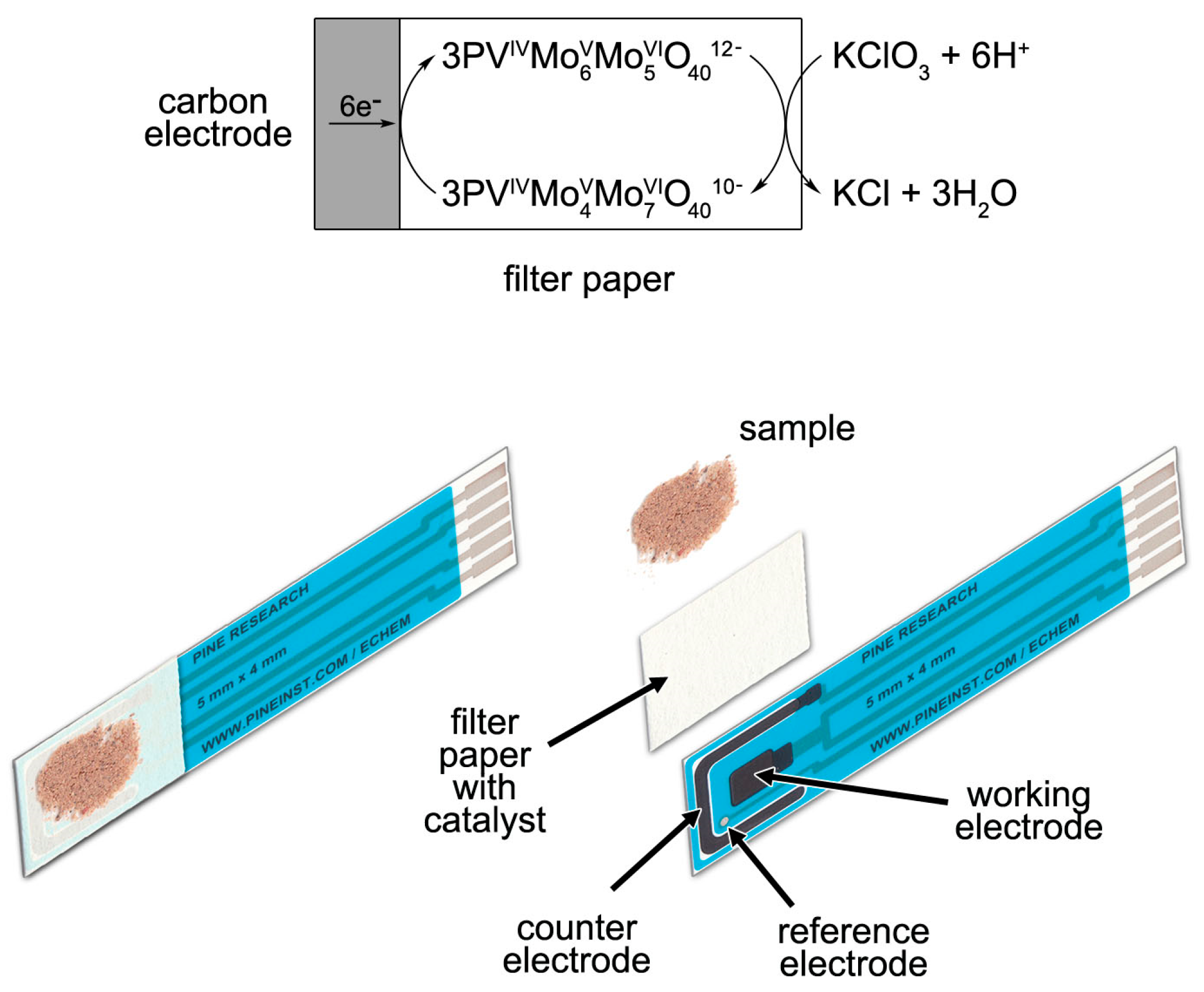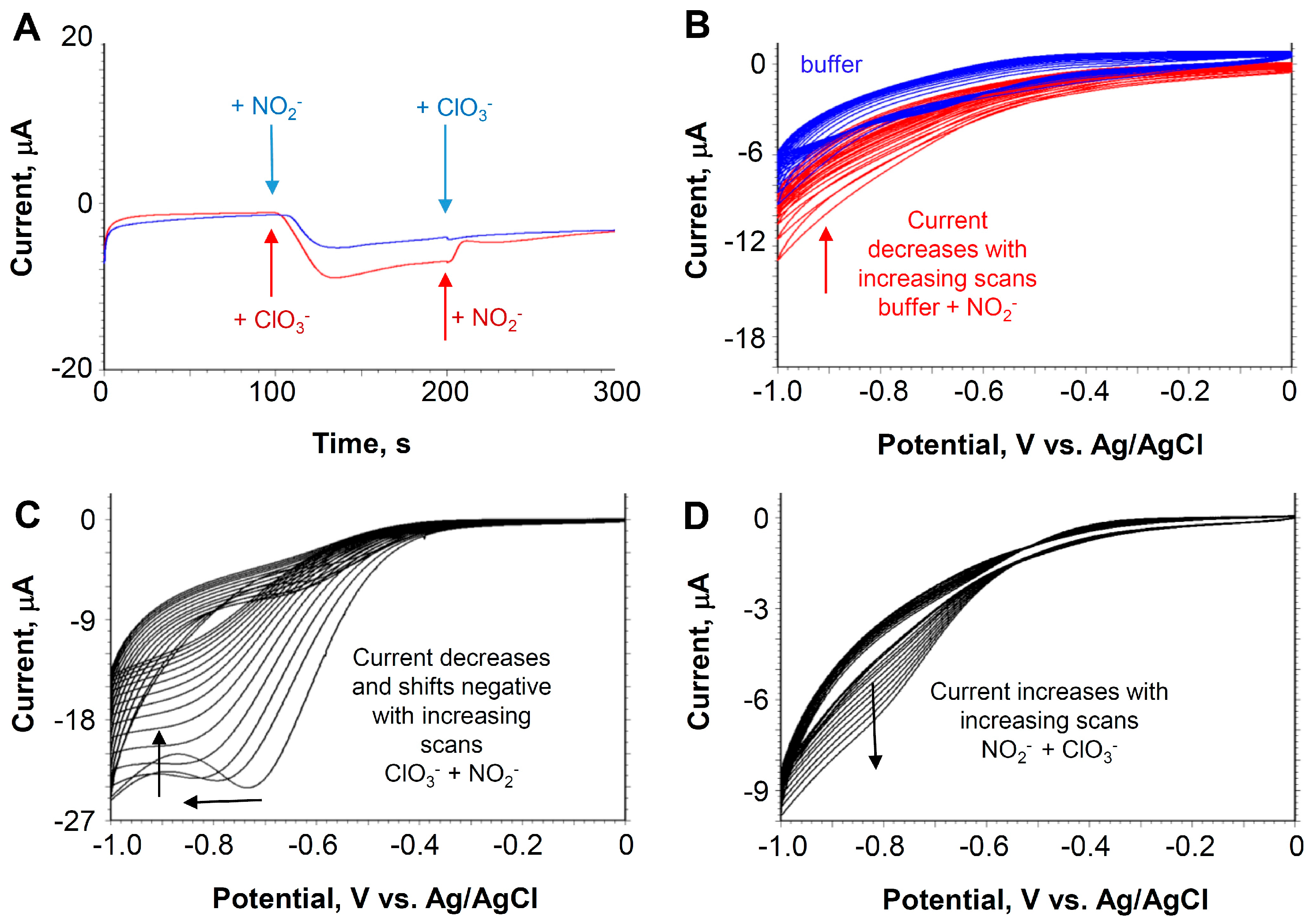Paper-Based Electrochemical Detection of Chlorate
Abstract
:1. Introduction
2. Materials and Methods
2.1. Materials
2.2. Measurements
2.3. Paper-Based Electrochemical Probe
2.4. Soil Assay
3. Results and Discussion
3.1. Detection of Chlorate
3.2. Selectivity
3.3. Soil Assay
3.4. Digital Simulation
4. Conclusions
Acknowledgments
Author Contributions
Conflicts of Interest
References
- Trammell, S.A.; Shriver-Lake, L.C.; Dressick, W.J. Statistical evaluation of an electrochemical probe for the detection of chlorate. Sens. Actuators B Chem. 2017, 239, 951–961. [Google Scholar] [CrossRef]
- Ryan, P.; Zabetakis, D.; Stenger, D.A.; Trammell, S.A. Integrating paper chromatography with electrochemical detection for the trace analysis of tnt in soil. Sensors 2015, 15, 17048–17056. [Google Scholar] [CrossRef] [PubMed]
- Erickson, J.S.; Shriver-Lake, L.C.; Zabetakis, D.; Stenger, D.A.; Trammell, S.A. A simple and inexpensive electrochemical assay for the identification of nitrogen containing explosives in the field. Sensors 2017, 17, 1769. [Google Scholar] [CrossRef] [PubMed]
- Almaviva, S.; Chirico, R.; Nuvoli, M.; Palucci, A.; Schnurer, F.; Schweikert, W. A new eye-safe uv raman spectrometer for the remote detection of energetic materials in fingerprint concentrations: Characterization by pca and roc analyzes. Talanta 2015, 144, 420–426. [Google Scholar] [CrossRef] [PubMed]
- Guo, Y.H.; Wang, X.T.; Miao, B.; Li, Y.; Yao, W.R.; Xie, Y.F.; Li, J.D.; Wu, D.M.; Pei, R.J. An aunps-functionalized algan/gan high electron mobility transistor sensor for ultrasensitive detection of tnt. RSC Adv. 2015, 5, 98724–98729. [Google Scholar] [CrossRef]
- Jamil, A.K.M.; Izake, E.L.; Sivanesan, A.; Agoston, R.; Ayoko, G.A. A homogeneous surface-enhanced raman scattering platform for ultra-trace detection of trinitrotoluene in the environment. Anal. Methods 2015, 7, 3863–3868. [Google Scholar] [CrossRef]
- Komarova, N.V.; Andrianova, M.S.; Gubanova, O.V.; Kuznetsov, E.V.; Kuznetsov, A.E. Development of a novel enzymatic biosensor based on an ion-selective field effect transistor for the detection of explosives. Sens. Actuators B-Chem. 2015, 221, 1017–1026. [Google Scholar] [CrossRef]
- Giordano, B.C.; Field, C.R.; Andrews, B.; Lubrano, A.; Woytowitz, M.; Rogers, D.; Collins, G.E. Trace explosives vapor generation and quantitation at parts per quadrillion concentrations. Anal. Chem. 2016, 88, 3747–3753. [Google Scholar] [CrossRef] [PubMed]
- Wang, J. Electrochemical sensing of explosives. Electroanalysis 2007, 19, 415–423. [Google Scholar] [CrossRef]
- Burns, E.A. Spectrophotometric determination of chlorate impurities in ammonium perchlorate—Determination of reducing and oxidizing impurities in hydrochloric acid. Anal. Chem. 1960, 32, 1800–1803. [Google Scholar] [CrossRef]
- Urone, P.; Bonde, E. Colorimetric determination of chlorates in well waters. Anal. Chem. 1960, 32, 1666–1668. [Google Scholar] [CrossRef]
- Trautwein, N.L.; Guyon, J.C. Spectrophotometric determination of chlorate ion. Anal. Chim. Acta 1968, 41, 275–285. [Google Scholar] [CrossRef]
- Chiswell, B.; Kellerlehmann, B. Spectrophotometric method for the determination of chlorite and chlorate. Analyst 1993, 118, 1457–1459. [Google Scholar] [CrossRef]
- Hosseini, S.G.; Pourmortazavi, S.M.; Gholivand, K. Spectrophotometric determination of chlorate ions in drinking water. Desalination 2009, 245, 298–305. [Google Scholar] [CrossRef]
- Rowe, A.A.; Bonham, A.J.; White, R.J.; Zimmer, M.P.; Yadgar, R.J.; Hobza, T.M.; Honea, J.W.; Ben-Yaacov, I.; Plaxco, K.W. Cheapstat: An open-source, “do-it-yourself” potentiostat for analytical and educational applications. PLoS ONE 2011, 6, e23783. [Google Scholar] [CrossRef] [PubMed]
- Tue-Ngeun, O.; Jakmunee, J.; Grudpan, K. A novel stopped flow injection-amperometric procedure for the determination of chlorate. Talanta 2005, 68, 459–464. [Google Scholar] [CrossRef] [PubMed]
- Somnam, S.; Grudpan, K.; Jakmunee, J. Stopped-flow injection spectrophotometric method for determination of chlorate in soil. MAEJO Int. J. Sci. Technol. 2008, 2, 383–390. [Google Scholar]
- Unoura, K.; Iwashita, A.; Itabashi, E.; Tanaka, N. Catalytic effects of chlorate ions on the electrode-reaction processes of 12-molybdophosphate and 12-molybdosilicate. Bull. Chem. Soc. Jpn. 1984, 57, 597–598. [Google Scholar] [CrossRef]
- Sadakane, M.; Steckhan, E. Electrochemical properties of polyoxometalates as electrocatalysts. Chem. Rev. 1998, 98, 219–237. [Google Scholar] [CrossRef] [PubMed]
- Fernandes, D.M.; Teixeira, A.; Freire, C. Multielectrocatalysis by layer-by-layer films based on pararosaniline and vanadium-substituted phosphomolybdate. Langmuir 2015, 31, 1855–1865. [Google Scholar] [CrossRef] [PubMed]
- Mialane, P.; Marrot, J.; Riviere, E.; Nebout, J.; Herve, G. Structural characterization and magnetic properties of sandwich-type tungstoarsenate complexes. Study of a mixed-valent VIV2/VV heteropolyanion. Inorg. Chem. 2001, 40, 44–48. [Google Scholar] [PubMed]
- Contant, R.; Abbessi, M.; Thouvenot, R.; Herve, G. Dawson type heteropolyanions. 3. Syntheses and 31p, 51v, and 183w nmr structural investigation of octadeca(molybdo-tungsto-vanado)diphosphates related to the [h2p2w12o48]12-anion. Inorg. Chem. 2004, 43, 3597–3604. [Google Scholar] [CrossRef] [PubMed]
- Lopez, X.; Bo, C.; Poblet, J.M. Electronic properties of polyoxometalates: Electron and proton affinity of mixed-addenda keggin and wells-dawson anions. J. Am. Chem. Soc. 2002, 124, 12574–12582. [Google Scholar] [CrossRef] [PubMed]
- Himeno, S.; Ishio, N. A voltammetric study on the formation of v(v)- and v(iv)-substituted molybdophosphate(v) complexes in aqueous solution. J. Electroanal. Chem. 1998, 451, 203–209. [Google Scholar] [CrossRef]
- Harris, D.C. Quantitative Chemical Analysis, 7th ed.; W.H. Freeman and Co.: New York, NY, USA, 2007. [Google Scholar]
- Boussema, F.; Haddad, R.; Ghandour, Y.; Belkhiria, M.S.; Holzinger, M.; Maaref, A.; Cosnier, S. Polyoxometalate [PMo11O39]7−/carbon nanocomposites for sensitive amperometric detection of nitrite. Electrochim. Acta 2016, 222, 402–408. [Google Scholar] [CrossRef]








| Electrochemical Technique | Linear Range (mg/mL) | Sensitivity | LOD a (mg/mL) |
|---|---|---|---|
| Cyclic voltammetry, Ipc vs. dose | 0.156–1.25 | 8.2 μA per 1 mg/mL | 0.083 |
| Chronocoulometry, charge vs. dose | 0.625–2.5 | 2.6 mC per 1 mg/mL | 0.31 |
| Chronocoulometry, slope (charge/s) vs. dose | 0.312–2.5 | 0.25 mC/s per 1 mg/mL | 0.15 |
© 2018 by the authors. Licensee MDPI, Basel, Switzerland. This article is an open access article distributed under the terms and conditions of the Creative Commons Attribution (CC BY) license (http://creativecommons.org/licenses/by/4.0/).
Share and Cite
Shriver-Lake, L.C.; Zabetakis, D.; Dressick, W.J.; Stenger, D.A.; Trammell, S.A. Paper-Based Electrochemical Detection of Chlorate. Sensors 2018, 18, 328. https://doi.org/10.3390/s18020328
Shriver-Lake LC, Zabetakis D, Dressick WJ, Stenger DA, Trammell SA. Paper-Based Electrochemical Detection of Chlorate. Sensors. 2018; 18(2):328. https://doi.org/10.3390/s18020328
Chicago/Turabian StyleShriver-Lake, Lisa C., Dan Zabetakis, Walter J. Dressick, David A. Stenger, and Scott A. Trammell. 2018. "Paper-Based Electrochemical Detection of Chlorate" Sensors 18, no. 2: 328. https://doi.org/10.3390/s18020328






